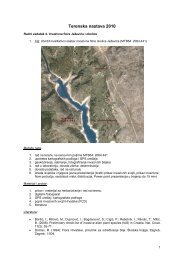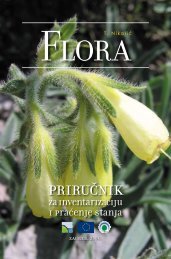important plant areas in central and eastern europe - hirc.botanic.hr ...
important plant areas in central and eastern europe - hirc.botanic.hr ...
important plant areas in central and eastern europe - hirc.botanic.hr ...
You also want an ePaper? Increase the reach of your titles
YUMPU automatically turns print PDFs into web optimized ePapers that Google loves.
Section 7IPAs <strong>and</strong> exist<strong>in</strong>g legislation<strong>and</strong> programmesIPA legal statusImportant Plant Areas are not legal site designations. Instead, they provide a frameworkfor identify<strong>in</strong>g the best sites for wild <strong>plant</strong>s, fungi <strong>and</strong> their habitats us<strong>in</strong>g consistentcriteria <strong>and</strong> sound data. IPAs provide the best available data from the <strong>botanic</strong>al <strong>and</strong>mycological communities, which is then available to <strong>in</strong>form national, regional <strong>and</strong> globalprotection <strong>and</strong> management schemes, <strong>in</strong>clud<strong>in</strong>g legally protected <strong>areas</strong>, site managementplann<strong>in</strong>g, agri-environment schemes, forestry management <strong>and</strong> general awareness-rais<strong>in</strong>gprojects.IPAs provide an <strong>important</strong> check on the <strong>plant</strong> conservation effectiveness of exist<strong>in</strong>gsystems of national <strong>and</strong> <strong>in</strong>ternational protected area systems, <strong>and</strong> biodiversityconservation strategies <strong>and</strong> policies.Although Important Plant Areas are not <strong>in</strong> themselves legally designated sites they doprovide the framework for signatory governments to fulfil their obligations to meet thetargets of the Convention on Biological Diversity (CBD) Global Strategy for PlantConservation (GSPC).Target 5 of the GSPC (Targets 1.4, 1.5 & 2.14 <strong>in</strong> the European Plant ConservationStrategy) requires signatory governments to ensure the protection of 50% of the most<strong>important</strong> <strong>areas</strong> for <strong>plant</strong>s by 2010. IPA projects provide a framework for assess<strong>in</strong>g <strong>and</strong>report<strong>in</strong>g on these targets.Pr<strong>in</strong>ciple of compatibility <strong>and</strong> supportIPAs are not <strong>in</strong>tended to compete with exist<strong>in</strong>g programmes <strong>and</strong> legislation. Instead theyare designed to be compatible with a range of regional <strong>and</strong> global conservation<strong>in</strong>itiatives. IPAs can provide essential <strong>in</strong>formation for the implementation of nationalconservation programmes, as well as contribut<strong>in</strong>g to the implementation of thelegislation <strong>and</strong> conservation programmes detailed below.NEJC JOGANThe M<strong>in</strong>ister of Environment, Macedonia(FYR), Mr Ljubomir Janer, at the 4th PlantaEuropa Conference, Spa<strong>in</strong> 2004.88
















